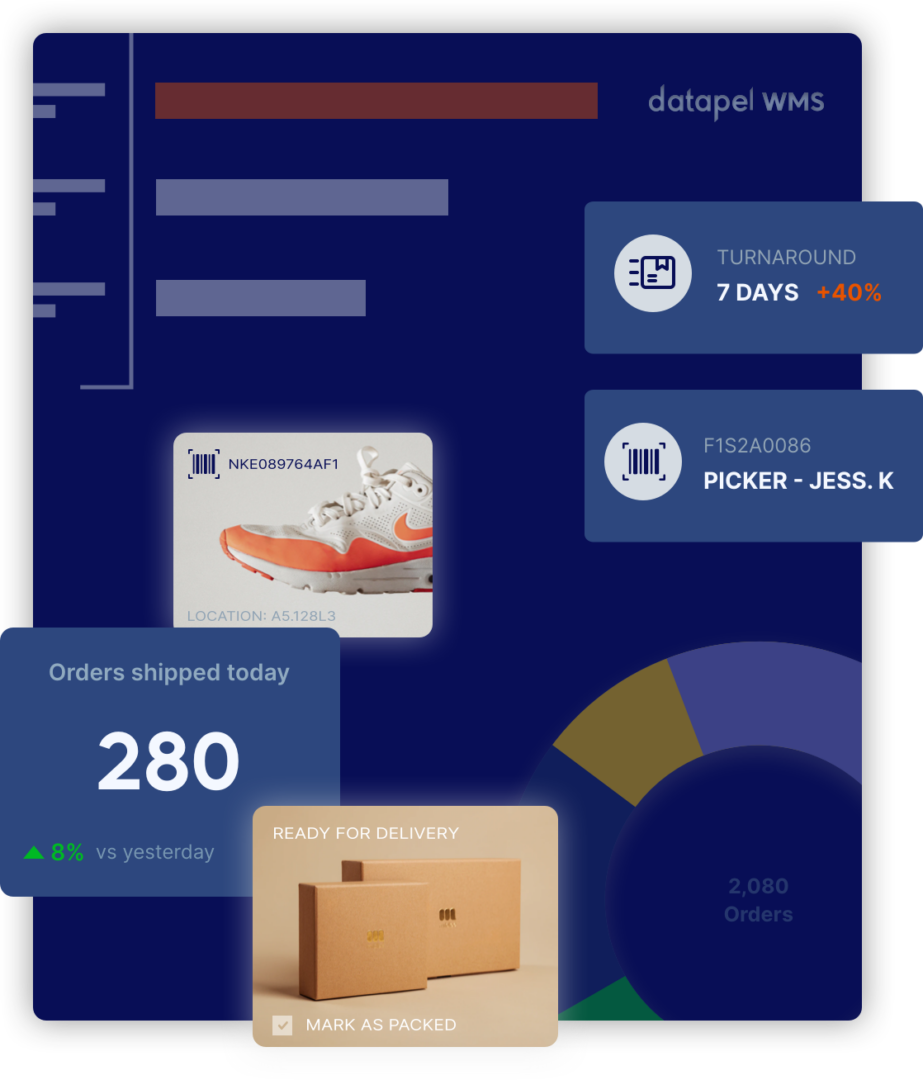Slash Lead Times with a Warehouse Management System (WMS)
Contents
Nobody likes late orders! Getting what you ordered on time, or even early, feels great. Making sure the order arrives when expected is a big part of making customers happy. The best way to do this is by cutting down on the time it takes to get the order ready and delivered, which we call “lead time.”
Lead time is the time it takes from when you start an order to when it’s finally delivered. This includes different stages of lead times like procurement, transportation, and distribution. Efficiently handling lead time well can be the difference between a supply chain that works smoothly and one that has trouble keeping up with what customers want.
In this article, you’ll learn more about lead time, how to calculate lead time, what causes delays, the important role of Warehouse Management Software in reducing lead times, and the best ways to make it all happen.
What is Lead Time?
Lead time signifies the total duration required for an order to progress from start to finish. These timeframes comprise several crucial components that collectively shape the journey of a product from conception to the hands of the customer. The lead time formula calculates this duration by subtracting the order received time from the order delivered time.

Types of Lead Time
There are several types of lead time in business and manufacturing.
- Material Lead Time: The time required to acquire the necessary raw materials or components for manufacturing the product. This entails processes such as sourcing, negotiation, and order placement.
- Production Lead Time: The duration it takes to transform raw materials into finished products. This encompasses various stages, such as processing, assembly, and quality control measures.
- Order Lead Time: The time it takes from order placement to order delivery, including processing, production, and transportation.
- Transportation Lead Time: The time taken to transport products from the manufacturing sites to distribution centres or directly to customers. This involves logistics planning, transit, and potential customs procedures.
- Distribution Lead Time: The time spent moving products from distribution centres to the final destination, whether it’s a retail store or directly to consumers.
- Management Lead Time: The time required for management decisions to be made and implemented, particularly in the context of planning, resource allocation, and strategic initiatives.
Factors Influencing Lead Times

Delivering a product involves a complex series of steps. While we aspire for a seamless process, various factors can disrupt it. Let’s look into some of the common factors that affect lead time, ultimately impacting the speed at which the products reach your customers:
- Demand Variability: Fluctuations in customer demand can lead to longer lead times, especially if production schedules and inventory levels aren’t adaptable enough to accommodate sudden spikes.
- Supplier Reliability: The punctuality and consistency of suppliers in delivering raw materials or components directly affect procurement lead times. Unreliable suppliers often lead to supply delays.
- Production Processes: The complexity of production, availability of machinery, and potential bottlenecks in the manufacturing process can elongate manufacturing lead times.
- Transportation Challenges: Delays in transit, customs clearance, and unexpected disruptions in transportation networks can contribute to extended transportation lead times.
- Inventory Management: Poor inventory planning can lead to stockouts or overstock situations, both of which impact cumulative lead times.
Importance of minimising lead times
Minimising lead times isn’t merely an operational goal; it’s a strategic imperative with far-reaching benefits. Here are some common advantages of optimising lead times.
- Enhanced Customer Satisfaction: Shorter lead times mean customers receive their orders sooner, resulting in happier customers who are more likely to return for future purchases.
- Operational Efficiency: Reduced lead times streamline operations by cutting down on unnecessary delays and inefficiencies, leading to optimal resource utilisation.
- Lower Operational Costs: Quicker lead times can reduce the need for excessive inventory storage and associated holding costs, contributing to cost savings.
- Agility in Responding to Market Changes: Shorter lead times allow businesses to adapt more swiftly to market shifts and emerging trends, giving them a competitive edge.
The Role of WMS in Lead Time Reduction
A Warehouse Management System (WMS) is a software designed to simplify, automate, and optimise inventory, orders, and warehouse tasks within the realm of supply chain management. From tracking inventory to managing orders, a WMS is vital for businesses seeking streamlined efficiency. However, to truly maximize efficiency, manufacturers must also embrace design for manufacturing principles into their operations. These principles focus on optimizing product designs for ease of manufacturing, minimizing production costs, and enhancing overall quality. Just as a WMS streamlines warehouse operations, DFM principles streamline the entire production process, ultimately contributing to increased competitiveness and profitability for businesses in today’s dynamic market landscape.
A well-implemented WMS acts as a powerful ally in the quest to trim lead times. Its impact on lead time reduction is multifaceted:
- Reduced Processing Time: Automation enabled by a WMS speeds up order processing, spanning from order reception to dispatch. This minimises reordering delays and significantly reduces the likelihood of errors caused by human intervention.
- Optimised Inventory Handling: Precise inventory tracking ensures swift picking, accurate packing, and efficient replenishment, contributing to total lead time reduction.
- Order Prioritisation: A WMS intelligently prioritises orders, ensuring high-priority orders are processed swiftly and dispatched promptly.
- Streamlined Workflows: By optimising the sequence of tasks, a WMS minimises unnecessary movements and wait times, optimising warehouse workflows.
- Enhanced Customer Communication: Real-time data provided by a WMS allows for accurate order tracking and communication with customers, keeping them informed about their orders’ progress.
Best Practices for Implementing a WMS to Enhance Lead Times

1. Thorough Assessment of Existing Processes
Before diving into Warehouse Management System (WMS) integration, it’s essential to gain an overall understanding of your current warehouse processes. This assessment involves evaluating workflows, identifying bottlenecks, and pinpointing areas that need improvement. This foundational step sets the stage for a successful integration that targets specific improvements in lead times.
2. Customisation of the WMS
No two warehouses are exactly alike, and your WMS should reflect your specific requirements. Customise the system to match your workflows, order processing protocols, and inventory management methods. This level of customisation ensures that the WMS seamlessly integrates into your operations, optimising processes and leading to tangible reductions in customer lead time.
3. Comprehensive Staff Training
Extract the maximum benefits from your WMS by investing in comprehensive staff training.
Ensure that your team is well-versed in navigating the WMS interface, utilising its features, and understanding how it impacts their day-to-day tasks. A well-trained workforce not only minimises the learning curve but also leverages the WMS to its fullest potential, ultimately contributing to more streamlined operations and quicker lead times.
4. Clear Communication and Change Management
Introducing a WMS can bring about significant changes in how tasks are executed and managed. Effective communication with your team about the upcoming changes is vital. Clearly outline the benefits of the WMS, explain how it will impact their roles, and address any concerns they might have. A well-managed change process can minimise resistance, ensure smooth adoption, and pave the way for improved lead times.
5. Data Migration and Integration
If you’re transitioning from a manual or legacy system to a WMS, data migration is a critical step. Ensure that your historical data, inventory records, and order histories are accurately migrated to the new system.
Additionally, integrate the WMS with your other business systems, like the Enterprise Resource Planning (ERP) software, to maintain seamless data flow across the organisation. This integration fosters real-time visibility and accurate decision-making, positively impacting lead times.
6. Continuous Monitoring and Optimisation
WMS implementation isn’t a one-time task; it’s an ongoing journey. Regularly monitor the system’s performance and gather data on key metrics such as order processing time, inventory accuracy, and lead times. Analyse these metrics to identify areas that can be further optimised.
Continuous improvement initiatives based on data-driven insights will lead to gradual yet consistent reductions in lead times over a duration of time.
Drive Down Lead Times with Datapel
Datapel is your catalyst for lead time reduction. As the business landscape races forward, meeting customer demands for faster service is imperative.
Our solution combines advanced order management and inventory control workflows, setting you on the path to industry best practices. This streamlined approach enhances order accuracy and productivity, efficiently meeting customer expectations. With Datapel, you’re equipped to optimise your processes, shrink lead times, and excel in a market that thrives on speed and efficiency.

In my role, I oversee the development of insightful blogs that delve into the intricacies of warehouse management. Each piece reflects my dedication to empowering businesses through informative content. Through my team’s extensive experience in the industry, we aim to bring clarity to the complexities of WMS, helping businesses make informed decisions.
Join me on a journey through the ever-evolving landscape of warehouse technology as we explore the latest trends, industry insights, and practical tips to streamline your operations. Feel free to connect, and let’s embark on a collaborative exploration of how WMS can redefine your business efficiency.
Cheers to innovation, efficiency, and the exciting world of warehouse management!







